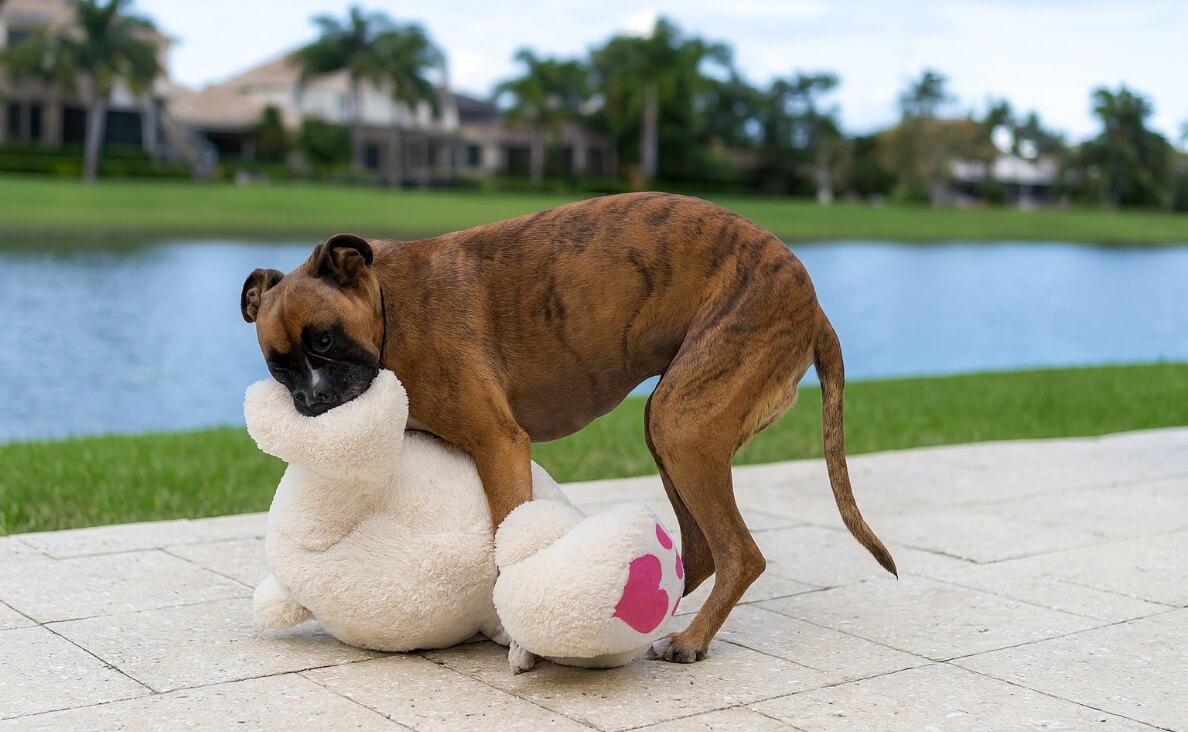
It’s one of the most awkward moments a dog parent can experience—your sweet pup suddenly starts humping your guest’s leg, a stuffed animal, or even the air. You’re mortified, your guests are confused, and you’re left wondering: why do dogs hump? Are they being dominant? Are they trying to mate? Or is something else going on?
The truth is, humping is a very common dog behavior, and it doesn’t always mean what people think. In this post, we’ll explain why dogs hump, when it’s a problem, and how to stop it in a positive, effective way.
Why Do Dogs Hump? The Real Reasons Behind the Behavior
Understanding the cause of your dog’s humping is the first step in addressing it. So, why do dogs hump? There are several possible reasons—some are behavioral, others medical, and not all are related to sex or dominance.
-
Play Behavior and Excitement
Many puppies and young dogs hump during play. It’s a way to explore new behaviors and release excess energy. You might notice humping during roughhousing, especially when a dog is overstimulated or doesn’t know how to calm down. This type of humping is usually harmless, though it should still be gently redirected.
-
Stress or Anxiety
Humping can also be a self-soothing behavior when a dog is feeling anxious or overwhelmed. Changes in routine, unfamiliar visitors, or chaotic environments may trigger humping. In these cases, the behavior is more about emotional regulation than anything else.
-
Attention-Seeking or Habitual Behavior
Some dogs learn that humping gets a reaction—whether it’s laughter, scolding, or redirection. If you’ve ever shouted, “No!” or tried to pull your dog away in front of guests, your pup may have learned that humping is a quick way to get attention.
-
Hormonal Behavior in Intact Dogs
This is the explanation most people assume, and it does play a role—especially in unneutered male dogs. However, humping isn’t limited to males or to sexual motivation. Female dogs and even spayed/neutered dogs can exhibit humping for non-sexual reasons.
-
Medical Issues
If your dog suddenly starts humping frequently or obsessively, it’s worth ruling out medical causes. Urinary tract infections, allergies, skin irritation, and even neurological disorders can lead to humping. If the behavior seems out of character or is accompanied by licking, whining, or signs of discomfort, talk to your veterinarian.
-
Social Status or Misunderstood Dominance
It’s a common myth that humping is always about dominance. While some dogs may use mounting to navigate social relationships with other dogs, it’s rarely a sign of trying to “take control.” More often, it’s play, stress, or confusion. True dominance behavior is more nuanced and typically involves multiple cues, not just mounting.

Should You Let Your Dog Hump Things?
It depends. If your dog occasionally humps a stuffed animal or pillow and it’s not obsessive or disruptive, it may not be a big concern. But if the behavior becomes compulsive, is directed at people or other animals, or happens in inappropriate settings, it’s best to intervene.
Set clear, consistent boundaries. Allowing some humping while discouraging others can be confusing for your dog. Choose what’s acceptable for your household and stick to it.
When Is Dog Humping a Problem?
Humping becomes problematic when:
- It happens excessively or obsessively
- It causes tension with other pets or people
- Your dog seems anxious, agitated, or unable to stop
- It disrupts daily life or social situations
In these cases, humping is no longer just a harmless quirk—it’s a behavior that needs to be addressed thoughtfully.
When to See a Veterinarian
While most humping behavior is harmless and behavioral, there are times when it could signal a medical issue. If your dog suddenly starts humping more than usual—or if the behavior seems obsessive—it’s wise to consult your veterinarian.
Here are signs that warrant a vet visit:
- Sudden onset of frequent humping with no clear trigger
- Licking or biting at the genitals or hindquarters
- Whining, restlessness, or signs of discomfort during or after humping
- Difficulty urinating or changes in urination habits
- Skin irritation, redness, or swelling in the groin area
- Changes in appetite, mood, or energy levels
Medical causes may include urinary tract infections, allergies, skin conditions, or even hormonal imbalances. In rare cases, compulsive humping may stem from neurological issues.
A veterinary exam can rule out health problems and give you peace of mind. If no medical issue is found, your vet may recommend working with a certified dog trainer or behaviorist to address the behavior from a behavioral standpoint.

How to Stop This Embarrassing Habit
So now that we’ve explored why dogs hump, how do you help them stop? Here are some effective, positive strategies to reduce or eliminate humping behavior:
-
Interrupt and Redirect
When you see your dog begin to mount, calmly interrupt them with a consistent command like “leave it” or “come.” Then redirect them to a toy, a game, or another behavior that’s incompatible with humping—like sitting, playing fetch, or doing a puzzle toy.
-
Increase Exercise and Mental Stimulation
A bored dog is a humpy dog. Many dogs hump simply because they have too much pent-up energy. Daily walks, sniff breaks, interactive play, and enrichment activities (like snuffle mats or treat puzzles) can help meet their physical and mental needs.
-
Minimize Humping Opportunities
Remove items your dog tends to hump, like certain toys or pillows. Avoid overly stimulating environments where the behavior typically escalates. If your dog tends to hump during rowdy playdates, limit those interactions or supervise them closely.
-
Stay Neutral—Don’t Reinforce It
Reacting with laughter, anger, or embarrassment can unintentionally reward the behavior. Dogs are very responsive to attention—even negative attention. Instead, stay calm, interrupt the behavior, and redirect.
-
Spay or Neuter (If Appropriate)
If your dog is intact and their humping seems hormonally driven, spaying or neutering may help. However, this is not a guaranteed solution, especially if the behavior has become habitual or anxiety-based.
-
Work With a Trainer or Behaviorist
If humping is persistent, compulsive, or accompanied by aggression, it’s time to call in a professional. A certified trainer or behaviorist can help you uncover the root cause and create a personalized behavior modification plan.

Dog Humping FAQ
Why does my dog hump me?
Usually, it’s a mix of excitement, attention-seeking, or stress—not attraction or dominance.
Why do dogs hump the air?
Air humping often happens when dogs are overstimulated, frustrated, or engaging in a repetitive behavior. It can also be medical.
Why is my dog humping my cat?
This is often play or confusion. It may also be a stress response or an attempt to initiate interaction. Supervise these interactions closely.
Is humping a sign of dominance?
Not always. Most humping behavior is due to arousal, excitement, or stress—not a desire to dominate.
Will my dog stop humping after neutering?
It may help, especially in younger dogs with hormonally driven behavior. But it’s not guaranteed to eliminate humping that is rooted in habit or anxiety.
Conclusion
So, why do dogs hump? The answer isn’t as simple as you might think. Dogs hump for a variety of reasons—play, anxiety, habit, hormones, or even medical issues. While the behavior can be embarrassing, it’s not uncommon, and with consistent redirection and care, most dogs can learn healthier ways to cope and interact.
If your dog’s humping is becoming a problem, don’t worry—you have plenty of options, from simple training to professional help.
Have you ever dealt with dog humping behavior? What worked—or didn’t—for you? Share your experience in the comments below!

 How to Curb Unwanted Chewing in Puppies
How to Curb Unwanted Chewing in Puppies 9 Tips for Getting Your Dog to Stop Barking
9 Tips for Getting Your Dog to Stop Barking What You Should Know About Our New Dog Obedience Training Program
What You Should Know About Our New Dog Obedience Training Program How to Get Your Dog’s Attention Using the “Watch Me” Command
How to Get Your Dog’s Attention Using the “Watch Me” Command Bitter Apple Spray for Dogs: Pros, Cons, and Top Alternatives
Bitter Apple Spray for Dogs: Pros, Cons, and Top Alternatives






Leave a Reply